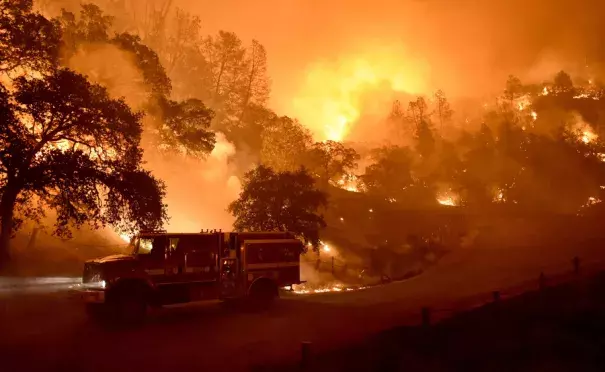Western Wildfire Season 2016
Climate disruption has extended wildfire seasons, expanded at risk areas, and increased fire size. This is particularly true for the western United States where both the frequency of large wildfires and the length of the fire season have increased substantially in recent decades thanks to higher temperatures, ongoing drought, earlier spring snowmelt and pine beetle infestations linked to warmer winter conditions. After the record-breaking US wildfire season of 2015, precipitation from the extreme 2015-2016 El Niño alleviated some drought concerns, but severe to exceptional drought remains over southern and central California and western Nevada.







Global warming amplifies the threat of wildfires through increased heat and drought, reduced snowpack, season shift and pine beetle outbreaks
According to the US National Academy of Sciences, over the past 30 years, there has been a fourfold increase in the number of large and long-duration forest fires in the American West.[1] The length of the fire season has expanded by 2.5 months, and the size of wildfires has increased severalfold.[1][2] More than half the US Western states have experienced their largest wildfire on record since 2000.[2]
Higher temperatures, reduced snowpack, and earlier onset of springtime are leading to increases in wildfire in the western United States,[3] while extreme droughts are becoming more frequent.[4] Climate change is also affecting the prevalence and distribution of pine beetles, because warmer winter conditions allow the beetles to breed more frequently and successfully.[5][6]
Wildfires decreasing air quality and harming human health has been well-established
Exposure to smoke from wildfires increases the number of hospitalizations and medical visits associated with health issues like asthma, bronchitis, respiratory infections, and lung illnesses.[7][8]
In Nevada’s Reno/Sparks area alone, the 2008 fire season resulted in almost $2 million in hospital costs from wildfires within a 350-mile radius.[9]
Кредит без відвідування банку забезпечує економію часу та мінімізує необхідність особистих контактів. Ця послуга особливо актуальна для людей, які цінують зручність і потребують термінових рішень. Оформлення кредиту без відвідування банку здійснюється онлайн через зручні платформи. Клієнт заповнює просту заявку, і після автоматичної обробки кошти зараховуються на картку. Такий формат виключає тривалі очікування у чергах або необхідність надавати великий пакет документів, роблячи процес максимально доступним. Водночас важливо звертати увагу на умови кредитування, зокрема на відсоткову ставку та графік погашення. Детальне ознайомлення з договором дозволить уникнути непередбачених витрат і забезпечить комфортне використання послуги.
Longer wildfire seasons and more costly fires are upending the US Forest Service budget
The United States spends roughly $2.0 to $2.5 billion on wildfire suppression per year, with suppression making up just a fraction of the total costs of a wildfire, which include damages to peoples' property, health and ecosystems and can be 10 to 50 times higher.[10]
Over the last few decades, wildfire costs have increased as a percent of the Forest Service’s budget as fire seasons have grown longer and more costly.[11]
From 1995 to 2015, the amount of the Forest Service's budget used to manage wildfires—which includes preparedness, suppression, FLAME, and related programs—has more than tripled from 16 percent to 52 percent, reducing the National Forest System's 2015 appropriation by nearly $475 million, or 32 percent.[11]
Коли виникає потреба у фінансовій підтримці, важливо знайти вигідне рішення, яке не обтяжить бюджет. Один із найкращих варіантів – це кредит без відсотків, що дозволяє позичити кошти без переплат. Ця послуга стає дедалі популярнішою завдяки своїй доступності та прозорим умовам. Зазвичай така пропозиція діє для нових клієнтів фінансових компаній. Ви можете отримати необхідну суму на певний період, не сплачуючи відсотки, якщо вчасно повернете гроші. Кредит без відсотків часто використовується для короткострокових потреб: оплати рахунків, покупок чи вирішення нагальних фінансових питань. Проте важливо уважно ознайомитися з умовами договору, зокрема з термінами погашення. Якщо ви не встигнете повернути суму вчасно, можуть бути нараховані додаткові платежі. Використовуючи такий кредит обдумано, ви отримуєте ефективний інструмент для вирішення фінансових питань без зайвих витрат.
The role of past fire management practices on wildfire trends varies by region
Past fire suppression has led to changes in fuels, fire frequency, and fire intensity in some southwestern ponderosa pine and Sierran forests but has had relatively little impact on fire activity in portions of the Rocky Mountains and in the low-lying grasses of southern California.[12]
Changes in firefighting practices over time—such as more frequent use of intentional burning to clear fuels as a fire suppression tactic—may have had impacts on the boundaries of burn areas, but generally, the effects of human development vary regionally, in some cases increasing fire activity and in others decreasing it.[12]
Western US trends for number of large fires in each ecoregion per year. The surrounding bar plots display the number of large fires in each ecoregion over the 1984–2011 study period.[13]
Related Content











